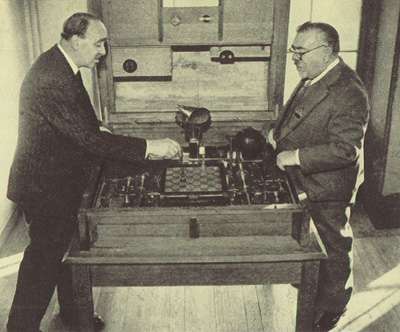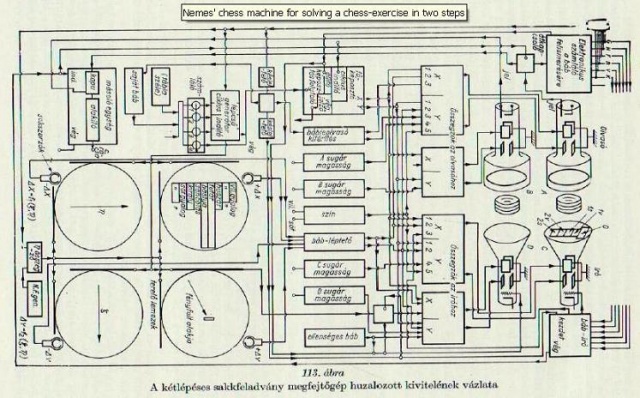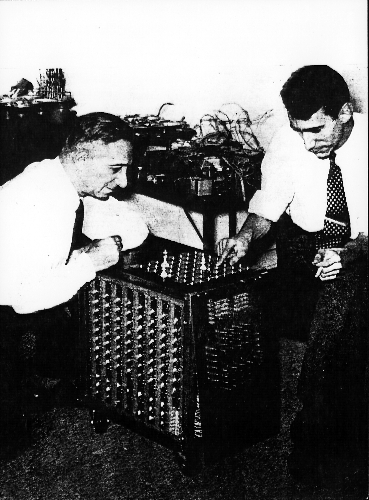Electro-Mechanical
Home * Hardware * Electro-Mechanical
Electro-Mechanical Computing Machines,
combine mechanical and electrical components to implement their discrete or digital combinatorial logic, and along with memory, sequential logic. Components include switches, electromagnetic actuators, and most commonly relays. While pure computing is nowadays the domain of electronics, Robots, including dedicated chess playing devices, along with their sensors and actuators are the domain of mechatronics, a design process that includes a combination of mechanical engineering, electrical engineering, control engineering and computer engineering.
Contents
Chess Machines
Beside the early mechanical and electro mechanical calculators and general purpose computers, like the relais computers by Konrad Zuse, Howard H. Aiken, and George Stibitz, there were early electro-mechanical dedicated chess machines, most notably El Ajedrecista, the electro-mechanical KRK Solver by Leonardo Torres y Quevedo of 1912 and Claude Shannon's relay-based chess machine, built in 1949, to play some endings with up to six pieces. Tihamér Nemes designed an electro-mechanical mate solver in the late 40's [1].
El Ajedrecista
see main article El Ajedrecista
Gonzalo Torres y Quevedo and Norbert Wiener, El Ajedrecista II [2] [3]
Nemes' Chess Machine
Nemes' design of a theoretical chess-machine [4]
Shannon's Chess Machine
Quote of the text on the back on the photo, as given in ICCA Journal, Vol. 12, No. 4: [5] :
Dr. Claude E. Shannon demonstrating to Chessmaster Edward Lasker his (home-made) electric chess automation, build in 1949. The machine could handle up to six pieces, and was designed to test various programming methods. With one hundred and fifty relay operations required to complete a move, it arrived at the reply to an opponent's play in ten to fifteen seconds. It had built into it a random element, and as a result did not necessarily always make the same move when faced with the same position.
Computer pioneer Claude Shannon and chess champion Edward Lasker at MIT, ponder the computational
aspects of playing chess at Shannon's early relay-based chess machine [6]
See also
Publications
- Henri Vigneron (1914). Les Automates. La Nature, pdf from cyberneticzoo.com, Translation by David Levy as Robots in David Levy, Monroe Newborn (1982). All About Chess and Computers. Springer, pp. 14-23, also in David Levy (ed.) (1988). Computer Chess Compendium, pp. 273-278.
- Anonymmous (1915). Torre and His Remarkable Automatic Devices. Scientific American, Supplement 80, Number 2079, November 06, 1915
- Claude Shannon (1938). A Symbolic Analysis of Relay and Switching Circuits. Transactions of the AIEE, Vol. 57, No 12, Master's thesis 1940, Massachusetts Institute of Technology
- Tihamér Nemes (1949). Chess automation. Magyar Sakkvilág, p. 51.
- Claude Shannon (1950). A Chess-Playing Machine. Scientific American, Vol. 182 (No. 2, February 1950), pp. 48-51. Reprinted in The World of Mathematics, edited by James R. Newman, Simon & Schuster, NY, Vol. 4, 1956, pp. 2124-2133. Included in Part B
- Tihamér Nemes (1951). The chessplaying machine. (Part II of the "Mechanical Solution of Diophantic Problems"), Acta Technica, p. 215., Hungarian Academy of Sciences, Budapest
- James M. Williams (1978). Antique Mechanical Computers, Part 3: The Torres Chess Automation. BYTE, Vol. 3, No. 9
- David Levy (1982). Robots. Translation of Henri Vigneron (1914). Les Automates. in David Levy, Monroe Newborn (1982). All About Chess and Computers. Springer, also in David Levy (ed.) (1988). Computer Chess Compendium, pp. 273-278. pdf from cyberneticzoo.com
- Brian Randell (1982). From Analytical Engine to Electronic Digital Computer: The Contributions of Ludgate, Torres, and Bush. Annals of the History of Computing, Vol. 4, No. 4, October 1982, pdf [7] [8] [9]
- Alexandre Khaldi, James A. Elliott, Stoyan K. Smoukov (2014). Electro-mechanical actuator with muscle memory. Journal of Materials Chemistry C
Forum Posts
- Relay based chess computing by Steven Edwards, CCC, May 03, 2016
External Links
- Microelectromechanical systems from Wikipedia
- Nanoelectromechanical systems from Wikipedia
- Mechatronics from Wikipedia
- Transducer from Wikipedia
- Finite-state machine
- Turing machine from Wikipedia
Mechanical Computers
- Mechanical computer from Wikipedia
- Difference engine from Wikipedia
- Analytical Engine from Wikipedia
- Z1 (computer)
Components
- Relay from Wikipedia
- Digitaltechnik - Realisierung mit Relais, Hohenstaufen-Gymnasium, Kaiserslautern (German)
Relay Computers
Early Computers
- History of Computers and Computing, The birth of the modern computer, First relays computers
- Model K from Wikipedia
- Z2 (computer) from Wikipedia
- Z3 (computer) from Wikipedia
- Harvard Mark I from Wikipedia
- Harvard Mark II from Wikipedia
- Simon (computer) from Wikipedia
- ARRA (computer) from Wikipedia
Hobby Projects
- Harry Porter's Relay Computer
- Relay Computer Two
- RC-3 Relay Computer
- Zusie - My Relay Computer
- i² 8-Bit Relay Computer - Home
References
- ↑ Tihamér Nemes (1949). Chess automation. Magyar Sakkvilág, p. 51
- ↑ A New Photograph of “El jugador ajedrecista,” the World’s First Chess Computer by Nathan Bauman, July 16th, 2006
- ↑ David Mindell, Jérôme Segal, Slava Gerovitch (2003). Cybernetics and Information Theory in the United States, France and the Soviet Union. in Mark Walker (ed.) (2003). Science and Ideology: A Comparative History. Routledge » Claude Shannon, Norbert Wiener, covers the 1951 Paris Cybernetic Congress
- ↑ A design of a theoretical chess-machine to solve chess exercises in two steps, from The Hungarian Ljapunov: Dr. Tihamér NEMES (1895-1960) (pdf)
- ↑ Photo of courtesy of Mrs. Shannon and Jos Uiterwijk, ICCA Journal, Vol. 12, No. 4, pp. 217. Quote of the text on the back on the photo
- ↑ Shannon and Lasker at Shannon's chess machine, ca. 1950 Gift of Monroe Newborn from The Computer History Museum
- ↑ Analytical Engine from Wikipedia
- ↑ Percy Ludgate from Wikipedia
- ↑ Vannevar Bush


